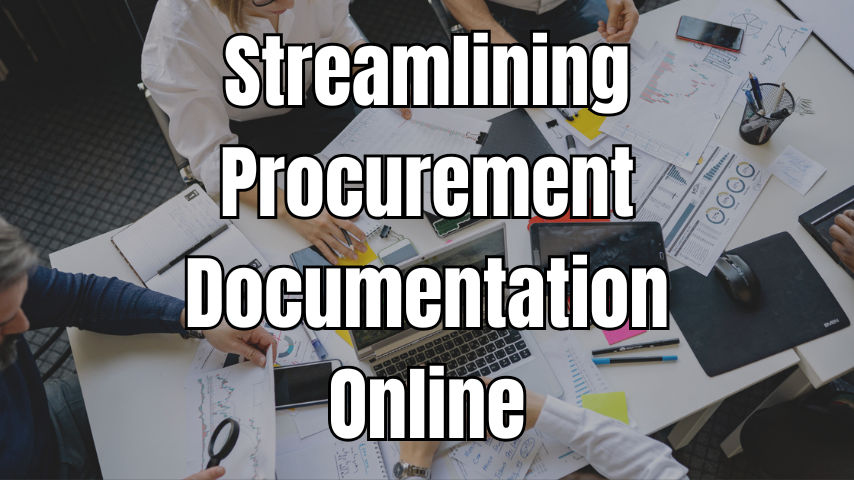Key Takeaways
- Streamlining procurement documentation improves efficiency, transparency, and compliance in business processes.
- Digital tools streamline document editing, merging, and conversion, reducing errors in procurement workflows.
- Key procurement documents include RFPs, invoices, contracts, purchase orders, and goods receipt notes.
Streamlined procurement documentation is critical to any organization seeking efficient and effective operations and the sustainability of competitiveness.
In today’s business world, which is pretty dynamic. Documenting adherence to policies and regulations aside, it also allows easy communication among stakeholders on the same page.
Despite this, many organizations face challenges in their procurement processes because of long manual workflows, among other version control issues as well as blunders in their procurement process. To face all these challenges, digital tools have emerged as a valuable asset, which can streamline procurement documentation through the fast editing, merging, and conversion characteristics of documents.
The application of all these technologies puts businesses on track more efficiently and reduces errors and bad cooperation, which ultimately brings better procurement results.
Understanding Procurement Documentation

Below is all that you need to know:
A. Definition and Purpose of Procurement Documentation
Procurement documentation covers the documents that detail the process, agreements, and transactional activities related to purchasing for an entity. Perhaps one of the most relevant purposes of documentation in procurement is its provision of transparency, accountabilities, and compliance throughout the entire procurement process. Procurement documentation therefore creates clear records about the requirements, negotiations, and agreements. An organization can look after its resources effectively by applying a systematic approach to purchases.
Types of Procurement Documents:
Besides other important documents, procurement involves several of them, all directed at a specific objective:
- Requests for Proposals (RFPs): These will detail the needs of an organization and will invite responses from suppliers. RFPs ensure that the suppliers understand what is needed of them so that proposals can be designed to be specifically adapted for them.
- Contracts: After the organization has chosen its supplier, the agreed supplier is then put into a contract, from which the agreement between the organization and the vendor derives its foundation. This is as such the terms of service include payment schedules, deliverables, and every other crucial condition stipulated in the contract which acts as a legal enforcer safeguarding the interests of both sides.
- Purchase Orders (POs): It is the seller’s document, issued by the buyer to record the purchase of his goods or services. The PO contains items, quantities, and agreed-upon prices and therefore can be referred to as an official record of the transaction.
- Change orders: Change orders represent a change to the original contract, which affects pricing and delivery times.
- Invoice: Invoice refers to the bill raised by the supplier to the buyer that contains an amount owed for goods or services rendered. Invoices have a vital role in paying the people and maintaining the record.
- Goods Receipt Notes: It is actually the record of those goods that have been received as against a purchase order. It is one of the major checkpoints in the procurement process.
Why Procurement Documentation Matters in Organizational Success
Effective procurement documentation is very crucial to the success of an organization for several reasons. First, it supports transparency in respect to audit trails regarding the decisions made, communications involved, and transactions undertaken, and it fosters trust among stakeholders. Maintaining quality documentation supports compliance with regulatory requirements because the risk associated with legal issues or penalties is reduced.
The Role of Digital Tools in Streamlining Procurement

Organizations can effectively improve documentation management by incorporating these functionalities into procurement processes while fostering an efficient and collaborative environment for work.
Editing PDFs for Proper Procurement Documentation
PDF editing ensures that procurement documents have the most accurate and updated information. PDF editors allow one to directly change their text, images, and layouts without forcing a person to change file format wherein an error may happen. This keeps contracts, proposals, and other key documents precise and easy to update.
Merging Procurement Documents into One File
Combining multiple procurement documents into one PDF simplifies document management. By merging RFPs, vendor contracts, and invoices into a single file, organizations streamline workflows and reduce miscommunication. This consolidation allows for easier access and a clear view of all procurement-related activities.
Splitting Large Documents for Easy Review and Distribution
Large procurement files, such as lengthy reports and contracts, can be divided into smaller and more manageable parts. By doing so, people can simply review and share what is most relevant to them, without viewing too much data; this makes the decision-making process more effective and makes collaboration with other team members much easier.
Improve Accessibility and Readability of Procurement Documents
Ensuring procurement documents are accessible and usable is fundamental for efficient collaboration. In today’s digital world, this is essential for organizational teams. Conversion tools and techniques help businesses tailor their procurement documentation to meet the specific needs of teams and stakeholders.
A. Converting PDFs to Editable Formats (Word/Excel/PowerPoint)

One major advantage of converting PDFs into Word, Excel, or PowerPoint is the ability to expand on the content. This allows for more elaboration and discussion about a topic. It also improves the flexibility of collaboration and editing. Procurement documents, in particular, often require feedback from multiple parties. By converting them, teams can edit directly in the document. This eliminates much of the back-and-forth that occurs when static PDF files are shared.
For instance, when converting a procurement contract from PDF to Word, it becomes easy for members of the team to make necessary adjustments, and thus all parties converge on terms and conditions.
Conversions of financial data from PDFs into an Excel sheet may make data analysis and budgeting possible, therefore allowing teams to creatively manipulate data to report on periods. Conversions to PowerPoint can be helpful in the presentation of procurement strategies and outcomes in visually appealing formats, aiding stakeholders.
B. Converting Files to Other Formats (JPG/JSON/XML)
While converting PDFs to editable text format is useful, at times you need to convert a document to some other file types, such as JPG, JSON, or XML. For instance, procurement documents are sometimes full of charts or images that can quickly be converted to JPG format for inclusion in presentations or reports.
JSON and XML formats are essential for integrating procurement data into software applications or systems. These formats enable interoperability. By translating data, they ensure exchangeability across multiple platforms. This makes it easier to integrate procurement information into broader organizational workflows.
C. Utilizing Tools to Remove Backgrounds from Images in Procurement Documents
Professional appearance matters much in procurement documentation since these may reflect the standards and commitment towards quality from the organization. Tools or apps that can remove the background of images generally make the procurement document visually clearer. Logos, charts, and images embedded into a contract can be cleaned off their distracting backgrounds to make the contract read much better and appear much clearer.
The Ending Remarks
Streamlining procurement documentation is vital for organizations to maintain efficiency, transparency, and compliance in their purchasing processes. By utilizing digital tools businesses can simplify document management, improve collaboration, and reduce errors. As technology continues to evolve, adopting these tools ensures that procurement practices remain agile and aligned with modern business demands.




More Stories
Washing Machine Maintenance in Riyadh
Best LG Washing Machines Repair in Jeddah
Exploring the Role of Medical AI Chatbots in Enhancing Patient Feedback Systems